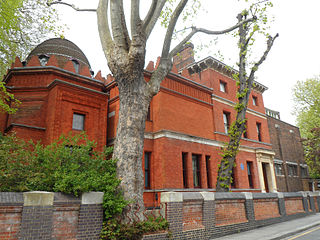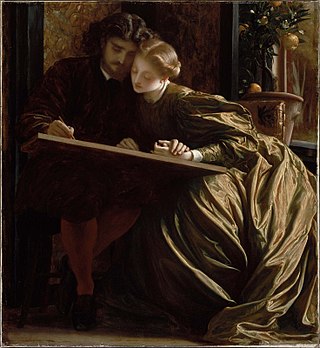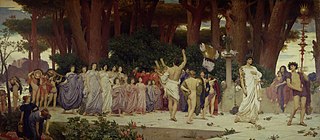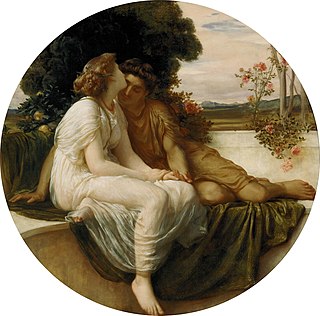
Frederic Leighton, 1st Baron Leighton,, known as Sir Frederic Leighton between 1878 and 1896, was a British Victorian painter, draughtsman, and sculptor. His works depicted historical, biblical, and classical subject matter in an academic style. His paintings were enormously popular and expensive, during his lifetime, but fell out of critical favour for many decades in the early 20th century.

Sir Edwin Henry Landseer was an English painter and sculptor, well known for his paintings of animals – particularly horses, dogs, and stags. However, his best-known works are the lion sculptures at the base of Nelson's Column in Trafalgar Square.

The Leighton House Museum is an art museum and historic house in the Holland Park area of the Royal Borough of Kensington and Chelsea in west London.

Dorothy Dene, born Ada Alice Pullen, was an English stage actress and artist's model for the painter Frederick Leighton and some of his associates. Dene was considered to have a classical face and figure and a flawless complexion. Her height was above average and she had long arms, large violet eyes and abundant golden chestnut hair.

The Painter's Honeymoon is an oil painting on canvas by the English painter Frederic Leighton, 1st Baron Leighton, produced c. 1864 and now in the Museum of Fine Arts, Boston.

Cimabue's Celebrated Madonna, originally called Cimabue's [Celebrated] Madonna [is] Carried in Procession through the Streets of Florence, is an oil painting by English artist Frederic Leighton. Measuring more than two metres tall and more than five metres wide, the canvas was painted by Leighton from 1853 to 1855 in Rome as his first major work.

Cymon and Iphigenia is an oil on canvas painting by Frederic Leighton, 1st Baron Leighton. The painting does not bear a date but was first exhibited at the Royal Academy of Arts, London, in 1884. The Art Gallery of New South Wales in Sydney, Australia, purchased it at a Christie's auction in London in 1976.
The Bath of Psyche is an oil painting by Frederic Leighton, first exhibited in 1890. It is in the collection of Tate Britain.
Crenaia, the Nymph of the Dargle is an oil painting by Frederic Leighton, first exhibited in 1880. It is in the collection of Juan Antonio Pérez Simón.

The Fisherman and the Syren is an oil painting by Frederic Leighton, first exhibited in 1858. It is a composition of two small full-length figures, a mermaid clasping a fisherman round the neck. The picture is in the collection of the Bristol Museum & Art Gallery.

Venus Disrobing for the Bath is an oil painting by Frederic Leighton, first exhibited in 1867.

Actaea, the Nymph of the Shore is an oil painting by Frederic Leighton, first exhibited in 1868.

Winding the Skein is an oil painting by Frederic Leighton, first exhibited in 1878.

Nausicaa is an oil painting by Frederic Leighton, first exhibited in 1878.

The Music Lesson is an oil painting by Frederic Leighton, first exhibited in 1877.

The Daphnephoria is an oil painting by Frederic Leighton, first exhibited in 1876.

Acme and Septimius is an oil painting by Frederic Leighton, first exhibited in 1868. Leighton took the subject from a love poem by the Roman poet Catullus.

Psamathe is an oil painting by Frederic Leighton, first exhibited in 1880.
Idyll I, sometimes called Θύρσις ('Thyrsis'), is a bucolic poem by the 3rd-century BC Greek poet Theocritus which takes the form of a dialogue between two rustics in a pastoral setting. Thyrsis meets a goatherd in a shady place beside a spring, and at his invitation sings the story of Daphnis. This ideal hero of Greek pastoral song had won for his bride the fairest of the Nymphs. Confident in the strength of his passion, he boasted that Love could never subdue him to a new affection. Love avenged himself by making Daphnis desire a strange maiden, but to this temptation he never yielded, and so died a constant lover. The song tells how the cattle and the wild things of the wood bewailed him, how Hermes and Priapus gave him counsel in vain, and how with his last breath he retorted the taunts of Aphrodite.
Idyll XV, also called "The Women at the Adonis-Festival" in English, is a mime by the 3rd-century BC Greek poet Theocritus. This idyll describes the visit paid by two Syracusan women residing in Alexandria, to the festival of the resurrection of Adonis.

















